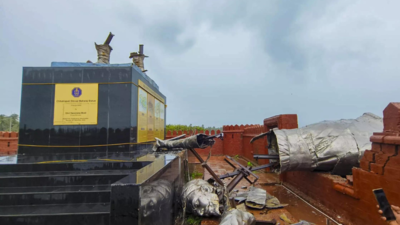The arrest of sculptor Jaydeep Apte follows the dramatic collapse of the Chhatrapati Shivaji Maharaj statue in Mumbai, a major incident that has sparked widespread concern and scrutiny. The statue, an iconic tribute to the Maratha king, collapsed during a recent installation attempt, leading to significant property damage and public outcry.
Apte, who was initially reported missing after the incident, was apprehended by police late last night. Authorities allege that Apte’s arrest is linked to allegations of negligence and failure to adhere to safety protocols during the statue’s construction and installation. This incident has triggered a broader discussion on the regulatory oversight of public art installations and the responsibilities of contractors and artists in ensuring public safety.
The statue, which was commissioned to celebrate the 350th anniversary of Shivaji Maharaj’s coronation, was intended to be a prominent landmark in Mumbai’s urban landscape. The collapse occurred just days before the scheduled unveiling, drawing immediate attention from local authorities and the media. Reports suggest that the statue’s structural integrity was compromised due to faulty construction practices.
Initial investigations reveal that Apte’s design and construction methods did not meet the required safety standards, contributing to the statue’s instability. Eyewitnesses reported hearing a loud cracking sound before the statue toppled, which led to immediate evacuations of the area to prevent casualties. Fortunately, no injuries were reported, but the incident resulted in considerable financial loss and damaged the surrounding infrastructure.
The Mumbai Municipal Corporation has launched an independent inquiry into the incident, with a focus on determining the causes behind the statue’s collapse and assessing the safety measures in place. The inquiry will also review whether proper permissions and clearances were obtained before the statue’s installation.
The legal consequences for Apte could be severe, involving charges related to public endangerment and violation of construction regulations. Authorities are expected to file formal charges soon as the investigation progresses. Apte’s arrest has further intensified discussions about accountability in the art and construction sectors, highlighting the need for stricter compliance with safety norms.
Public reaction has been one of shock and dismay, with many expressing concerns over the quality of public works and the adequacy of oversight mechanisms. Local leaders and activists have called for comprehensive reforms to ensure that such incidents do not recur and that similar projects adhere to high safety standards.
This incident also raises broader questions about the role of artistic expression in public spaces and the balance between creativity and safety. The collapse of such a significant cultural monument has underscored the necessity for rigorous safety checks and quality assurance in all public art projects.
The controversy surrounding the statue has attracted national attention, prompting discussions on social media and news platforms about the implications of the collapse. Critics argue that the failure to enforce stringent regulations reflects poorly on the governance of public projects and the oversight capabilities of municipal authorities.




 Trudeau Faces Major Setback as Jagmeet Singh Withdraws Support
Trudeau Faces Major Setback as Jagmeet Singh Withdraws Support 